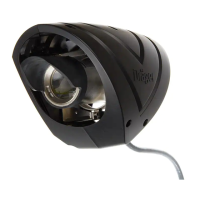Understanding The System
7
Digital communications
Dräger Polytron Pulsar 2s comprehensive digital information can be made available by different routes to suit the level of complexity
required. In the simplest installations only the 4 20mA analogue signal is brought to the Non-hazardous Area. Then a pre-warning condi-
tion (such as dirty lenses or misalignment, before they cause a loss of operation) is signalled as a DC level, configurable to be either
above or below 4mA. For instance, the Regard Optical Card shows 'WARN' and energises a relay for the default 3.5mA setting. Thus
alerted, the user connects the Handheld Terminal to the Receiver head. Present readings are displayed on its screen, while past data can
be downloaded into the Terminal's internal memory and hence transferred to a computer in the Non-hazardous Area. Similarly, changes to
the configuration settings which affect safety can be entered (with password protection) into the Draeger PLMS software running on the
PC and the resulting configuration file carried to the Dräger Polytron Pulsar 2 in the Hazardous Area.
A new feature with Dräger Polytron Pulsar 2 allows HART signals to be superimposed on the 4 20mA wire without affecting the normal
analogue functions. Installations that include a HART multiplexer in the Non-Hazardous Area provide much of Dräger Polytron Pulsar 2s
digital capability in a way that is compatible with HART-enabled point detectors. Typically the multiplexer is interfaced to a central compu-
ter running the Asset Management System (AMS) from Emerson Process Management which communicates with both types of detector
interchangeably.
The next simplest category of installation brings the single digital wire from the Receiver into the Non-hazardous Area, augmenting the
basic measurement carried by the 4 20mA loop. The full array of digital information is made available by the AI500 interface, a small unit
mounted on a DIN/EN rail with terminals for up to four Dräger Polytron Pulsar 2s. A separate connector for the Handheld Terminal allows
a user to 'call up' any of the four Dräger Polytron Pulsar 2s Receivers, read their measured data, change their configurations, and down-
load their logs; all as if he had gone to the Dräger Polytron Pulsar 2s themselves. The AI500 also has an infrared data output which ena-
bles a standard notebook PC to capture the measured data and logs using the Data Wand DW100. This method is non-contacting and
allows the data be taken with no possibility of affecting the safe operation of the system.
Finally, the most comprehensive class of installations has up to 32 AI500 interfaces linked to a PC or other central system via an EIA RS
485 multidrop. Draeger PLMS software running on the PC addresses the total system of up to 128 Dräger Polytron Pulsar 2s, providing
full current and historical information and the ability to configure each detector individually.

